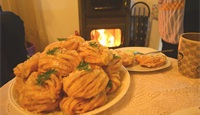
Applicant:
Kilani Villagers Association
Communities Concerned - Bearers of the element:
Kilani Villagers Association, Kilani Community Council, Kilani inhabitants – bearers of the knowledge of making “Glydjista”.
Domain of Intangible Cultural Heritage:
Traditional nutrition and customary practices
Date of inscription:
2017
Geographical distribution:
The art of making “glydjista” sweets is still preserved in its authentic traditional form, and transmitted from mother to daughter or from grand-mother to grand-daughter mainly in the community of Kilani.
Brief description:
The traditional Kilani “glydjista” are a type of dessert made of strands of pastry interwoven in a braid that are fried and dipped in syrup. They are then sprinkled with sesame seeds and decorated with scented geranium [Pelargonium]. Many of the village customs are associated with the production of “glydjista”:
-
They are offered as a gift from relatives and friends to a new mother when they visit her straight after she’s had a baby.
-
They are offered as a treat or a sweet offering given at a christening.
-
They are the sweet offering at an engagement.
-
They are the treat the bride-to-be would use as a “bribe” to the groom’s uncles and aunts by offering them a plate each once she is engaged.
-
If the engagement is on the first of May, the bride should give the groom a large garland and her mother-in-law a plate full of “glydjista” to sop her.
-
This was the treat the bride would offer before the wedding, more specifically on the day she would bathe inside the large earthenware vessel (“pithari”) in the presence of relatives and friends as well as of the village musicians, the violinist and the lute player.
As the “glydjista” were made on the occasion of happy events (engagements, weddings, etc.), the Kilani women would not add any cinnamon because cinnamon is ripped out from the bark of a tree and they obviously wouldn’t want the engagement or the happy event to be “ripped apart” in the same manner. It emerges that the entire process of making “glydjista” in Kilani reflects the village history, social interactions and customs. The Kilani women refer to the “glydjista” as “objets d’art” or Kilani “confectionery lace-making”.